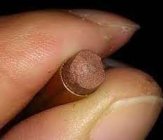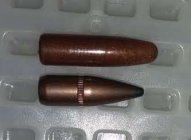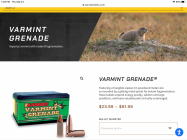So I bought some copper solid bullets, 45gr .224. I didn't much think about anything other than price, they were cheap and available. I wanted them for fire forming my 22K Hornet cases and figured they'd be fine. The fastest twist rate that I have in a 22K Hornet is 1:12 and shooting these bullets from that rifle I couldn't reliably hit a 2'x3' steel plate at 25 yards, and the bullets when they did hit were hitting sideways to the plate instead of head on. The bullets sat on my shelf for several months. One other thing is when I tried to pull the bullets with a kinetic puller they would snap off just above the neck instead of coming out of the case neck. They appear to be compressed powder with some sort of bonding agent or maybe just compressed under high pressure.
Well last week I decided to try them in an AR that I have with 1:8 barrel and with some load development they will shoot 1/2 MOA out to 50 and I have not yet tried them to 100 yet. The other bullet in the picture is a 55gr soft point .224 and you can see the difference in length and weight distribution. The 55gr bullets do just fine in even 1:14 barrels.


Well last week I decided to try them in an AR that I have with 1:8 barrel and with some load development they will shoot 1/2 MOA out to 50 and I have not yet tried them to 100 yet. The other bullet in the picture is a 55gr soft point .224 and you can see the difference in length and weight distribution. The 55gr bullets do just fine in even 1:14 barrels.













